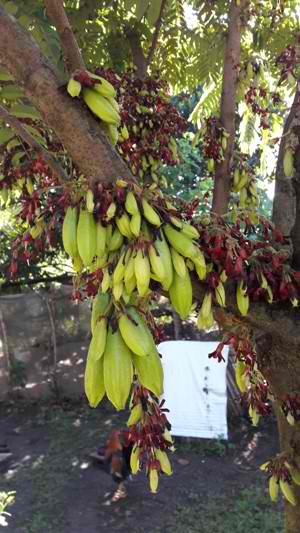An all-women group dubbed as Kilos Unlad ng Mamayan ng Real (KUMARE), Inc. has seen the great potential of kamias (Averrhoa bilimbi Linn.) by turning this underutilized crop as additional source of income.
Based in Real, Quezon, KUMARE is now commercializing kamias commonly known as bilimbi, cucumber tree, or tree sorrel, which are growing abundantly in Quezon.

Kamias grows in clusters and the tree is often found in backyards. It is commonly eaten raw or dipped in rock salt or dried to be used as souring ingredient in cooking traditional Filipino dishes like paksiw or sinigang. They are also processed into pickled, dried candies, and juice.
Beyond its uses as food, kamias is also believed to have medicinal properties and is used as treatment on itches or skin eruptions, rheumatism, swelling, or mumps. Not to forget the common rural use in whitening fingernails, bleaching or removing stains in clothes or rust and tarnish from brass.
With more than 2, 000 active members in the municipalities of Real, Infanta, General Nakar, and Polilio, KUMARE members are active participants in various community projects and programs. Furthermore, they are willing to participate in livelihood and income-generating activities especially those on processing and product commercialization.
KUMARE stands based on the principle of “empowering women to live their lives as fully as possible”. This can be achieved by helping them improve their economic situations, achieving a higher education for their children, having adequate health education and assistance and caring for the environment.
Seeing the potential of kamias, the Department of Agriculture-Quezon Agricultural Research and Experiment Station (DA-QARES) packaged a proposal titled, “Commercializing Kamias (Averrhoa balimbi Linn) Production and Utilization for the Women Group KUMARE of Real, Quezon.” The project was funded by the Bureau of Agricultural Research under its National Technology Commercialization Program (NTCP).
“Research progression on how to reduce the over utilization of primary crops by looking into the use of underutilized crops can be a good alternative and additional source of income. One promising crop, which is locally abundant and can offer lot of benefit, is kamias,” Dennis Bihis, project leader, explained.
He shared that trials on propagation by seeds and trials using asexual propagation are being conducted. Trials were done since kamias is relatively harder to propagate and seeds do not readily germinate. To date, 5,000 seedlings were produced where 2,500 seedlings were distributed to members of the beneficiary group and other interested clients for establishment of groves. “Based on initial results, 90 percent success rate in propagating kamias through seeds (soaked in water for 15 minutes at room temperature) has been noted,” Bihis said.
Members of the KUMARE group already attended training on kamias production, field management, and product development spearheaded by DA-QARES. Existing products developed from kamias include soap, prunes, and candy. Trials are currently being conducted to assess the oxalic acid content of the fruits to be used as bleach or anti-browning agent.
Kamias soap and sinigang powder are now available in local markets and KUMARE’s business outlet in Real, Quezon. Market linkage has been made for the two products and will be done also for other products once these have been analyzed and packaged.
The group is looking into tapping the bustling tourist industry of the province and arrangements are being made to supply products to beach resorts, hotels, and other establishments.
Venturing into the production of soap, candy, and prunes proved profitable with a return on investment of 161 percent with a payback period of one year and seven months. Sensitivity analysis was also conducted and production of the three products will still be viable given the 10 percent increase in gross cost or 10 percent decrease in gross profit scenarios.
Bihis added that beneficiaries will be given additional training on the package of technology of the crop and on value-adding technologies; and equipment for product development have been provided that they may continue implementing the project even after project completion and after funding support. ### (Ma. Eloisa H. Aquino)- bar.gov.ph

